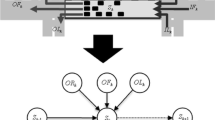Abstract
In this paper, an arterial signal control method based on the modified arrival-based (AB) model is investigated using an improved biologically inspired hill climbing algorithm. The AB model is used to derive an amended objective function model with a membership function for signal cognitive optimization. Next, a modified hill climbing algorithm is proposed to strengthen the adaptive ability of intersections for disturbed traffic flow. At the same time, the probability of searching the globally optimal solutions is improved in the cognitive process. Finally, simulation results verify the applicability of the optimized AB model and the effectiveness of the improved hill climbing algorithm compared with conventional fixed-time control.















Similar content being viewed by others
References
Sánchez N, Alfonso J, Torres J, et al. ITS-based cooperative services development framework for improving safety of vulnerable road users. Intell Transp Syst IET. 2013;7(2):236–43.
Dotoli M, Fanti MP, Meloni C. A signal timing plan formulation for urban traffic control. Control Eng Pract. 2006;14:1297–311.
Ciprian D. Using intelligent traffic lights to reduce vehicle emissions. Int J Innov Comput Inform Control. 2012;8(9):6283–302.
Webster FV. Traffic signal setting. Road Research (Tech Paper No. 39). Great Britain Road Research Laboratory; 1952. p. 50–8.
Akcelik R. Route control of traffic in urban road networks: review and principles. Transp Res. 1977;11(1):15–24.
Transportation Research Board. Highway capacity manual. Washington, D. C.: National Research Council; 2000.
ElZohairy YM. Multi-regime arrival rate uniform delay models for signalized intersections. Transp Res A: Policy Pract. 2001;35(7):625–27.
Wey W, Jayakrishnan R, McNally MG. A local feedback controller for oversaturated intersection control based on dynamic road traffic models. In: Vehicle navigation and information systems conference, proceedings, in conjunction with the Pacific Rim transtech conference, international Vnis, a ride into the future. IEEE. 1995. p. 172–8.
Isaksen L, Payne HJ. Suboptimal control of linear systems by augmentation with application to freeway traffic regulation. Autom Control IEEE Trans. 1973;18:210–9.
Rivero-Angeles ME, Lara-Rodriguez D, Cruz-Perez FA. Random access control mechanisms using adaptive traffic load in ALOHA and CSMA strategies for EDGE. Ranaon Vhlar Hnology. 2005;54(3):1160–86.
Wenge M, Dayong G, Yan Y. Multi-phase fuzzy control of single intersection in traffic system base on genetic algorithm. Int J Innov Comput Inform Control. 2012;8(5):3387–97.
Amin N. On natural based optimization. Cogn Comput. 2010;2(2):97–119.
Johnson AW, Jacobson SH. A class of convergent generalized hill climbing algorithms. Appl Math Comput. 2002;125:359–73.
Johnson AW, Jacobson SH. On the convergence of generalized hill climbing algorithms. Disc Appl Math. 2002;119(2):37–57.
Afshar MH. A parameter free continuous ant colony optimization algorithm for the optimal design of storm sewer networks: constrained and unconstrained approach. Adv Eng Softw. 2010;41(2):188–95.
Zhang X, Wang L, Huang B. An improved niche ant colony algorithm for multi-modal function optimization. Instrumentation and Measurement, Sensor Network and Automation, International Symposium on. IEEE. 2012. p. 403–6.
Blum C, Dorigo M. The hyper-cube framework for ant colony optimization. Man Cybern B: Cybern IEEE Trans. 2004;34(2):1161–72.
Mazzeo S, Loiseau I. An ant colony algorithm for the capacitated vehicle routing. Elect Notes Disc Math. 2004;18(1):181–6.
Datta T, Misra IS. A comparative study of optimization techniques in adaptive antenna array processing: the bacteria-foraging algorithm and particle-swarm optimization. Antennas and Propag Mag IEEE. 2009;51(6):69–81.
Patchararungruang S, Halgamuge S, Shenoy N. Optimized rule-based delay proportion adjustment for proportional differentiated services. Sel Areas Commun IEEE J. 2005;23(2):261–76.
Qin T, Yi S, Cheng YH, Jian YZ, Wen YG. Swarm intelligence: based cooperation optimization of multi-modal. Funct Cogn Comput. 2013;5(1):48–55.
Li C, Yang S, Nguyen TT. A self-learning particle swarm optimizer for global optimization problems. Ym Man and Ybrn Ar B:ybrn Ranaon on. 2012;42:627–46.
Mohammad MR, John MB, Suzanne C. Creativity and autonomy in swarm intelligence systems. Cogn Comput. 2012;4(3):320–31.
Gong Y, Zhang J, Chung HS, et al. An efficient resource allocation scheme using particle swarm optimization. Evol Comput IEEE Trans. 2012;16(6):801–16.
Swan J, Woodward J, Özcan E, et al. Searching the hyper-heuristic design SPACE. Cogn Comput. 2014;6:66–73.
Acknowledgments
The project was supported by National Natural Science Foundation of China (61473146). The project funded by the Priority Academic Program Development of Jiangsu Higher Education Institutions.
Author information
Authors and Affiliations
Corresponding author
Rights and permissions
About this article
Cite this article
Chen, F., Wang, L., Jiang, B. et al. An Arterial Traffic Signal Control System Based on a Novel Intersections Model and Improved Hill Climbing Algorithm. Cogn Comput 7, 464–476 (2015). https://doi.org/10.1007/s12559-014-9314-8
Received:
Accepted:
Published:
Issue Date:
DOI: https://doi.org/10.1007/s12559-014-9314-8




